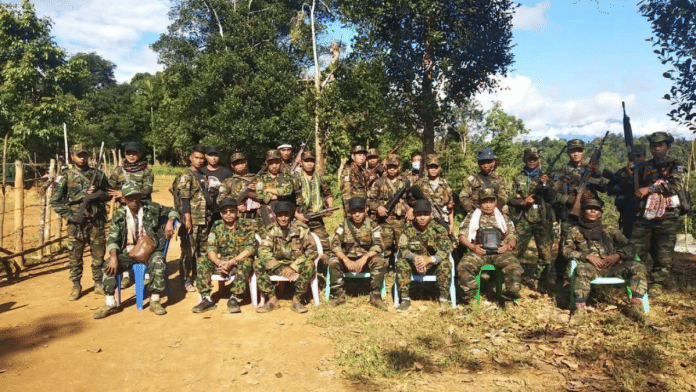Guwahati: Defections continue within the Yung Aung faction of the Myanmar-based National Socialist Council of Nagalim-Khaplang (NSCN-K), weakening it further in the ongoing tussle with another wing of the Naga separatist outfit.
On 21 November, a section of the Yung Aung group, led by senior leader Todimong, joined the NSCN-K faction under Ang Mai’s leadership, according to a statement released by the Naga group on 9 December. The official joining took place at Liutik village of Khondon Range in the Khiamniungan Region of Myanmar.
Formed in April 1988 under the leadership of Shangnyu Shangwang Khaplang, a Hemi Naga from Myanmar, the NSCN-K is based in the Naga Self-Administered Zone (NSAZ) of Sagaing Region in northwest Myanmar.
Its cadres are also active in parts of eastern Nagaland and Arunachal Pradesh close to the India-Myanmar border. After the Konyak Nagas, the Khiamniungan is the second largest Naga tribe living in the lower parts of the NSAZ.
A year after S.S. Khaplang’s death in Myanmar in 2017, the NSCN divided into two factions: one led by Indian-origin leader Khango Konyak, who was later impeached in an internal struggle, and the other led by Khaplang’s nephew, Yung Aung. The Ang Mai faction had come up in June 2023 after a split in the Yung Aung group.
The factions led by Yung Aung and Ang Mai are at loggerheads over leadership and governance issues. Sources within the Ang Mai faction told ThePrint that the outfit’s estimated strength could be around 2,000 cadres, including 300-400 Konyaks from the Indian side residing in western Myanmar.
Welcoming the new members, a NSCN-K Ang Mai faction spokesperson, who reportedly represented the outfit in discussions with the Centre, said that the people in the Khiamniuangan region desire peace and progress under the new leadership.
“It is a highly encouraging development, and we wholeheartedly welcome Maj. Gen. Todimong and his team to our government. Maj. Gen. Todimong, a veteran national leader, joined the movement in 1976 and has earned immense respect as a prominent figure of the Khiamniuangan tribe, as well as among the Nagas of the eastern region (India),” the spokesperson told ThePrint.
“The Khiamniuangan tribe has historically resisted being under the care of either the Myanmar or Indian governments. But, as the region progresses, the people seek peace, development, and change, which they recognise can only be achieved through the leadership of Ang Mai and Mulatonu,” he added.
In early December, the representatives of the NSCN-K Ang Mai-Mulatonu faction were in New Delhi for discussions to hammer out a possible ceasefire agreement with the Centre. A security source, however, had told ThePrint that there has been no real outcome from these talks.
Earlier, sources within the Ang Mai group said their leaders had met with authorities in Myanmar on several occasions, and reached an understanding regarding “free military operations” within the self-administered zone.
The ethnic Naga communities are spread across Myanmar and India, with different factions of the NSCN-K being led by leaders from both countries at various times. There are more than 27 factions of Naga political groups, each claiming to represent the Nagas. Last month, sources said, two more groups have come up because of splits in the existing ones.
Stakeholders in the ceasefire agreement with Centre include the NSCN-IM that signed the Framework Agreement in August 2015 to seek a final solution, the Naga National Political Groups (NNPGs) that arrived at an ‘Agreed Position’ two years later, and the NSCN Niki Sumi faction that entered into a ceasefire in 2021.
The NNPGs are a group of seven Naga outfits in talks with the Centre, but separately. The Niki Sumi faction is supposedly extending support to the NNPGs, according to the sources.
In Naga society, there is much concern that the Centre’s approach of encouraging ceasefire negotiations with multiple groups could lead to a “divided house”. While the Indian Naga leaders believe that the factionalism in Myanmar won’t impact their own peace talks, they have repeatedly called for the demand for an “early solution” to the Naga political issue.
The Northeast insurgent groups, including the NSCN-Isak-Muivah and the NNPGs, have only shown unity in their individual stances in the opposition to the scrapping of the Free Movement Regime (FMR) between India and Myanmar.
In October, H.S. Ramsan, a Myanmar-based dissident NSCN-IM leader, had joined the chorus against the Centre’s decision to revoke the FMR. Sources said Ramsan had been pressuring the NSCN-IM leadership to complete the political talks without any compromise on the rights of the Nagas.
(Edited by Tony Rai)
Also Read: Vibrant village programme bringing people back to LAC villages; tourists knocking






